The Art of Hover Surfing: Techniques and Tips
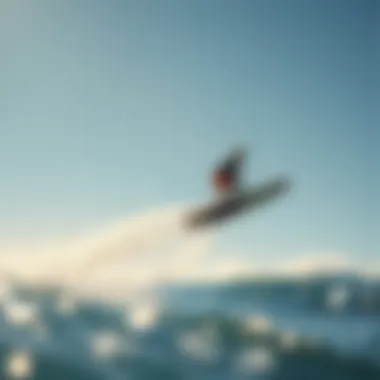
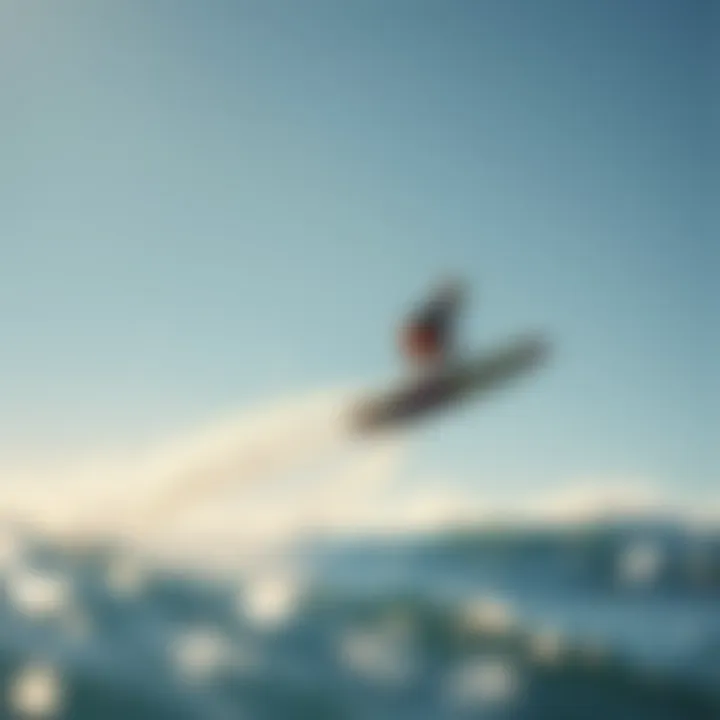
Intro
Hover surfing, an exhilarating blend of surfing, kiteboarding, and a dash of aerial acrobatics, has gained a devoted following among thrill-seekers around the globe. This sport transforms ordinary waves into playgrounds and opens up a realm of possibilities. Imagine harnessing the power of the wind while gliding above water, all while performing tricks that seem to defy gravity. With the right combination of gear, technique, and location, anyone can jump into this stunning experience. Whether you’re a seasoned kiteboarder or just starting your journey, mastering hover surfing involves knowing your equipment, safety practices, and effective techniques to improve your skills.
The essence of hover surfing is rooted deeply in understanding the nuances of the gear and the environment. If you’re curious about how to stand out on the waves while flying high, this guide covers everything from the basics of selecting the right gear to insights from experienced pros who’ve nailed their craft.
Let’s embark on this journey, navigating through the essentials that will elevate your hover surfing game to new heights.
Gear and Equipment
Hover surfing isn't just about the thrill; it’s about having the right tools at your disposal. The right gear not only enhances performance but also significantly impacts safety and enjoyment. Here, we’ll break down what you need to hit the waves.
Essential Kiteboarding Gear for Beginners
Diving into hover surfing can feel overwhelming at first, especially with the plethora of equipment options on the market. Below are the critical components every beginner should consider:
- Kite: Start with a kite that matches your skill level. An easy-to-control, beginner-friendly kite such as the Naish Fusion offers stability and ease of use.
- Board: Look for a lighter board that provides good buoyancy and ease of maneuvering, like the Slingshot Space PUDDLE. It’ll help you learn the basics without too much hassle.
- Harness: A proper harness should feel comfortable and secure. A waist harness generally works best for newbies, giving freedom of movement.
- Safety Gear: Don’t skimp on protection! A helmet, impact vest, and even a life vest can make a big difference, especially if you’re learning to navigate tricks and heights.
Advanced Equipment for Experienced Riders
For those who’ve been around the block and are ready to push their boundaries, consider upgrading your gear:
- High-Performance Kite: Models like the Cabrinha Switchblade are excellent for more dynamic conditions, allowing greater freedom in harder maneuvers.
- Specialized Board: A high-speed, lightweight board such as the Duotone Pro Wam aids in achieving aerial tricks with ease and stability.
- Advanced Harness Systems: Opt for a seat harness like the Mystic Star, which provides more freedom and minimizes fatigue during long sessions.
Choosing the right equipment can vastly improve your hover surfing experience. Investing in quality gear tailored to your level can make all the difference.
Techniques and Tips
Once you have your gear sorted, the next step is to refine your techniques. This ensures not just excitement but a safer experience while mastering the waves.
Safety Practices for Kiteboarding
Safety should always be top of mind, especially in an exhilarating sport like hover surfing. Here are a few practices to keep in mind:
- Pre-Flight Checks: Always verify the integrity of your kite and gear before heading out. Look for any wear and tear that may have developed.
- Understanding Wind Conditions: Before launching, assess wind patterns and consider your skill level; do not venture out in overly aggressive winds.
- Buddy System: Whenever possible, practice with a buddy. This ensures assistance is at hand in case something goes awry.
Training Techniques to Improve Your Skills
In hover surfing, there’s always room for advancement. Here are some training techniques to consider:
- Regular Practice: Consistency is key. Set a schedule that allows you to practice different maneuvers regularly.
- Video Analysis: Capture your sessions and watch them later. Seeing your movements can help identify areas for improvement.
- Join Workshops: Attend local workshops; they offer a great way to refine skills and learn from experienced instructors.
With the right approach to gear and technique, hover surfing can transform from a whimsical adventure to a finely honed skill. As this sport continues to evolve, the wave of new innovations and techniques is sure to keep the thrill alive. Get ready to take flight!
Preface to Hover Surfing
Hover surfing stands out in the realm of water sports, blending aspects of surfing, kiteboarding, and even elements of flying. This exhilarating activity has attracted a diverse crowd of enthusiasts—from kiteboarders seeking new thrills to adventurers searching for the next frontier in outdoor sports. Understanding the nuances of hover surfing is essential, not only to improve one’s skill level but also to appreciate the exhilarating dance between wind and water.
Defining Hover Surfing
Hover surfing, simply put, involves riding a board while being lifted by a kite that harnesses the wind. It's not merely a sport but an amalgamation of mechanics and artistry. Imagine gliding effortlessly across the water’s surface, propelled by nothing but the air's energy. The thrill lies in the height—you’re not just skimming across the waves but hovering above them, experiencing a perspective few activities can offer.
The board used for hover surfing typically has a specific construction, designed to optimize buoyancy and maneuverability. The kite, larger than that of standard kiteboarding, is engineered to catch more wind, granting the rider the ability to soar higher or traverse more challenging terrains. To truly define hover surfing is to acknowledge its fluid interplay of nature, technology, and human skill.
History and Evolution
Though it may seem like a modern innovation, hover surfing has roots that extend back to traditional surfing and early kite sports. The first foundations can be traced to the 1980s with the advent of modern kites, where pioneers began to experiment with combining flying kites and surfing the waves. Over decades, this nascent sport underwent various transformations, driven by advancements in materials and design.
In the early years, riders relied heavily on flimsy, less efficient kites paired with traditional surfboards. As technology advanced, the discipline broke away from its humble beginnings. Key developments, including durable lightweight materials for kites and specially crafted boards, have dramatically changed hover surfing's landscape, making it more accessible and thrilling.
The globalization of sports led to hover surfing discovering its footing in various locations worldwide—from the expansive beaches of the Caribbean to the windy cliffs of Cape Town. Events, workshops, and competitions have sprung up, further pushing the sport into the limelight. Riding the waves while suspended in air has transformed from an obscure pastime to a global phenomenon celebrated by a passionate community.
In summary, the rich history of hover surfing shows its evolution through innovation and communal passion, marking it not just as a sport but as an exhilarating lifestyle choice for many.
"Hover surfing is not just about the waves; it's an expression of freedom, defying the boundaries between sea and sky."
For individuals seeking to delve deeper into the sport, resources are plentiful. Sites like Wikipedia provide historical context, while forums like Reddit can connect you with seasoned surfers eager to share their experiences.
The Mechanics of Hover Surfing
Hover surfing is not just about catching the wind; it’s about harnessing the elemental forces of nature to allow riders to glide seamlessly over both water and air. Understanding the mechanics of hover surfing is essential for mastering this exhilarating activity. The way kites interact with the wind, coupled with the design and innovation of boards, significantly affects performance and safety. Here, we will delve into the particulars of kite dynamics, board innovations, and how wind conditions influence each ride.
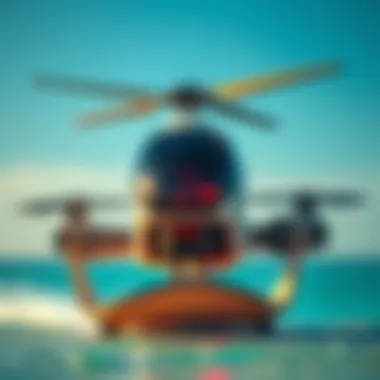
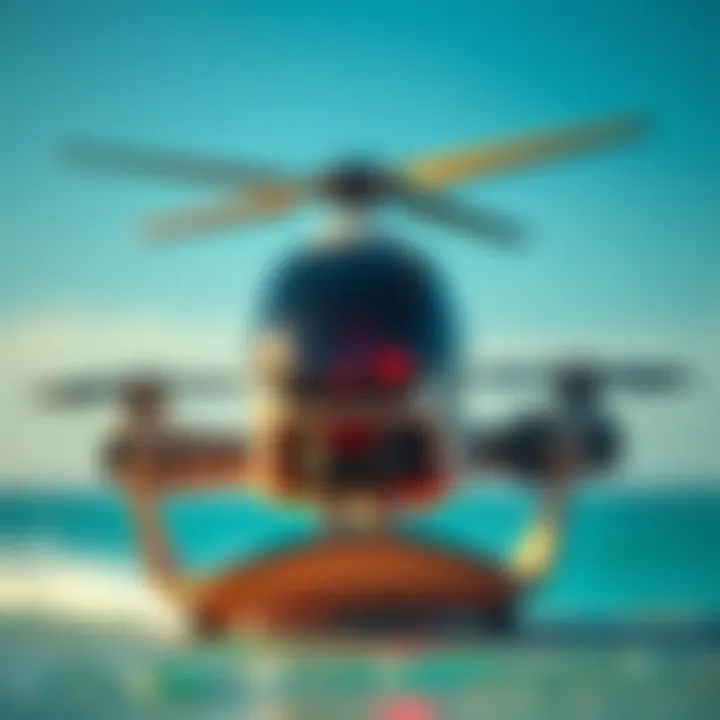
Understanding Kite Dynamics
Kite dynamics is the heart of hover surfing technique. Essentially, it involves how the kite interacts with the wind to create lift and control. A good grasp of this is crucial, especially for kiteboarders looking to enhance their skills.
When the kite is launched, it needs to maintain an optimal angle relative to the wind direction. If the angle is too steep, the kite will stall; too flat, and it might fall behind, reducing lift. Therefore, adjusting the kite’s position in relation to the wind is paramount.
Moreover, the choice of kite matters greatly. There's a diversity of designs — from Delta kites providing stability in gusty conditions to the C-kite known for its performance in maneuverability. Each type brings unique benefits:
- Delta Kites: Excellent for beginners due to their forgiving nature and stability.
- C-Kites: Favored by advanced riders for tricks due to their precise control.
Keeping in mind these dynamics of kites allows riders to ride smoother and more efficiently, thus reducing risk.
Board Designs and Innovations
The evolution of board technology has propelled hover surfing to new heights. Boards come in varied shapes and sizes, each designed to cater to different surfing preferences and conditions. Riders should consider how aspects like width, length, and rocker influence their performance.
For instance, a wider board provides more surface area, which is especially helpful for beginners as it offers greater stability. Conversely, narrower boards lend themselves to enhanced agility and speed — perfect for those wanting to showcase tricks.
Recent innovations in materials also deserve mention. Carbon fiber and epoxy boards are becoming popular due to their lightweight nature and strength, allowing for effortless maneuverability. This combination means that riders can perform at their best without the weight dragging them down.
Furthermore, venturing into the realm of modular designs, some manufacturers are now offering multi-functional boards. Riders can adapt them based on the conditions, switching between free-riding, jumping, or even wave riding. Such versatility makes it easier for enthusiasts to explore different styles without multiple purchases.
Wind Conditions and Their Effects
Wind is the unsung hero in the realm of hover surfing. The strength and consistency of wind can make or break a ride. Understanding how different wind conditions affect performance is pivotal in ensuring enjoyable and safe experiences.
It’s important to recognize that not all winds are created equal. Variability in wind strength means that riders should assess the conditions regularly. Here are some common scenarios:
- Light Winds (1-10 knots): Ideal for beginners utilizing larger kites for maximum lift and experience.
- Moderate Winds (11-20 knots): Suitable for intermediate surfers welcoming challenges with smaller kites.
- Strong Winds (21+ knots): Best left to experienced individuals skilled in handling tougher conditions, often requiring smaller kites to gain control.
Riders should never underestimate the impact of gusty winds either. These erratic bursts can surprise even seasoned surfers and, if not accounted for, could lead to accidents. Using tools like wind meters can assist in assessing environment wind conditions accurately.
"Understanding wind dynamics in hover surfing can mean the difference between a spectacular ride and a nasty fall."
By paying close attention to kite dynamics, board innovations, and fluctuating wind conditions, riders can significantly enhance their hover surfing experience. To master the waves and air, one must respect and leverage the mechanics at play — it's not just skill, it's strategy.
Essential Gear for Hover Surfing
When it comes to hover surfing, having the right gear can make or break your experience. This sport requires a blend of balance, agility, and good equipment. Each piece of gear serves a specific purpose, contributing to your overall performance and safety in the air and on the water. Understanding what to choose and how to maintain it is essential not only for enjoyment but also for enhancing your skills and ensuring your safety.
Kites: Selection and Maintenance
Choosing the right kite is fundamental in hover surfing. The type of kite affects your speed, maneuverability, and overall experience on the water. There are various types of kites, like delta, C-shaped, and bow kites, each with its strengths and weaknesses.
- Delta Kites: Great for beginners due to their stability. They work well in light winds, allowing you to enjoy your time without stressing over tricky conditions.
- C-Shaped Kites: These provide excellent power and control, making them favored among experienced surfers, especially when performing tricks.
- Bow Kites: These are versatile and can adapt to varying wind conditions, offering good lift and control.
After you've selected your kite, maintenance comes into play. Regular inspection for tears, checking lines for frays, and proper storage are crucial. Always make sure to rinse the kite with fresh water after a saltwater session to avoid corrosion. A well-maintained kite not only lasts longer but also performs better, which means smoother rides and fewer surprises.
Boards: Features and Functionality
Your choice of board can significantly affect your performance while hover surfing. Boards are tailored for different styles, and understanding their features is vital.
- Size and Shape: Shorter boards are generally more maneuverable, while longer ones offer more stability. Choosing the right length based on your height and skill level can enhance your control in the water.
- Material: Most boards are made from foam or fiberglass. Foam boards are usually lighter and easier to handle, making them a good pick for those just starting out. In contrast, fiberglass boards are more durable and ideal for advanced tricks.
- Footstraps: Ensure they are adjustable to fit your feet snugly. A proper fit can enhance your connection to the board, allowing for better balance and control during your rides.
Safety Equipment: Must-Have Items
Safety should always be a top priority in hover surfing. With the thrill of hovering above water, it's crucial to have the right safety equipment at your disposal.
- Helmet: Protects your head, especially during falls or unexpected collisions. Look for a lightweight model that fits snugly.
- Impact Vest: This adds buoyancy and provides padding against impacts from falling. It’s like wearing a hug both for comfort and protection.
- Leash: A paddle leash connects you to the board, minimizing the chances of losing it in the water. Always ensure it’s attached before starting your ride.
- Emergency Whistle: In case of getting into trouble or needing assistance, an easily accessible whistle could make a world of difference.
"When you’re above the water, the right gear is not just an accessory; it's your lifeline."
Having the essentials sorted out provides you with confidence to tackle the waves and explore the thrill of hovering through the air. Don’t skimp on gear—invest in quality, and you’ll reap the rewards over time. Navigating the art of hover surfing requires practice and the right tools to heighten your experience.
Safety Practices in Hover Surfing
Engaging in hover surfing can be an exhilarating experience, bringing together the thrill of riding the waves and the sensation of flying through the air. However, with such excitement comes an inherent need for safety practices. Not only does ensuring safety protect the individuals involved, but it also enhances the overall experience, allowing surfers to concentrate on mastering their skills rather than worrying about their wellbeing. Let's explore some crucial aspects of safety practices in hover surfing.
Pre-Surfing Safety Checks
Before strapping on your gear and plunging into the water, taking a moment to perform safety checks can save lives. This routine should never be overlooked. Here are some essential points to consider:
- Inspect Your Gear: Check your kite and board for any damages. Look for rips in the fabric or wear in the lines. A quick inspection can identify issues that might lead to accidents.
- Harness Fit: Make sure that your harness is secure and well-fitted. A loose harness can lead to serious injuries, especially when trying to control your kite.
- Wind Conditions: Assess the wind speed and direction. If the conditions are beyond your skill level, it's better to sit this one out.
- Buddy System: Whenever possible, have a friend tag along. Having someone to assist can greatly improve safety, especially in emergency situations.
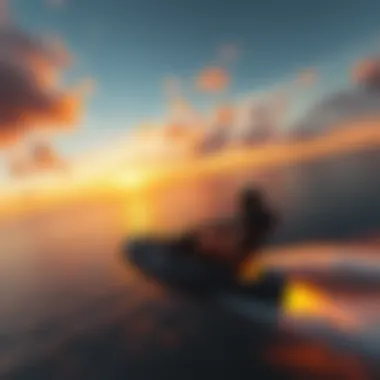
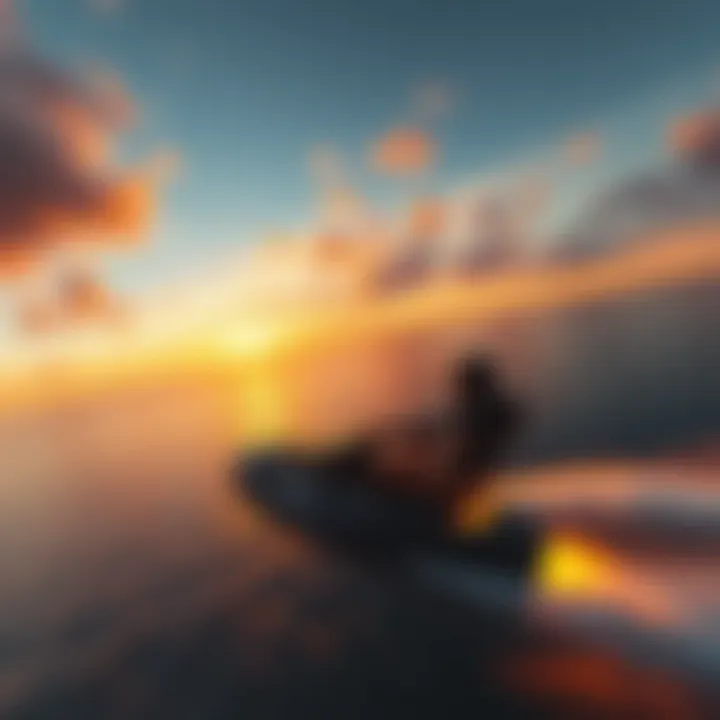
Completing these checks not only ensures you’re prepared for the water but also helps forge a sense of confidence, which is crucial for improved performance.
Identifying Environmental Hazards
Knowledge is power, especially when it comes to navigating the waters where you plan to hover surf. Environmental factors can change rapidly, and identifying potential hazards will keep you safe. Here are key environmental hazards to watch out for:
- Underwater Obstacles: Be mindful of rocks, reefs, and even jetties or piers that may not be visible surface. Colliding with these can lead to serious injuries.
- Wildlife: Animals such as jellyfish or sharks are a reality in many surf locations. Understanding which creatures inhabit your desired area will help you avoid unwanted encounters.
- Weather Changes: Pay attention to the forecast. Storms and sudden gusts can arise quickly. Have an exit plan ready and be prepared to head back to shore if conditions turn unfavorable.
- Other Water Users: Whether it's swimmers, surfers, or boaters, being aware of others in the water increases everyone's safety. Respect their space and signal your movements clearly to avoid collisions.
Being cognizant of these hazards not only ensures your safety but also cultivates a respect for nature and other enthusiasts.
Emergency Procedures
Accidents can happen regardless of preparation and skill, and knowing how to react in an emergency is crucial. Understanding emergency procedures can mean the difference between a minor setback and a serious situation. Here are a few important actions to have in mind:
- Surfing Alone: If you're by yourself and encounter a problem, use your whistle or signal mirror to draw attention. Always carry a signaling device.
- Kite Management: If your kite loses control or goes down, focus on managing it to prevent entanglement. Know how to perform a quick release or depower method.
- Self-Rescue Techniques: Familiarize yourself with techniques like body dragging or using your board for floatation. These skills can be lifesavers in specific situations.
- Calling for Help: If an emergency arises and you’re unable to self-rescue, don’t hesitate to call for help. Make sure you have your mobile device waterproofed or use a life-friendly alternative.
Preparedness is key in hover surfing; everyone should hope to never need to use these skills, but knowing them can ease fears and save lives. They are as crucial as the ride itself.
In the world of hover surfing, safety isn't just an afterthought. It’s the foundation upon which we build our skills and adventures. Without it, the experience can become perilous.
Understanding and implementing these safety practices can help ensure a fun and enjoyable hover surfing experience for all. For more information, consider visiting National Weather Service or American Red Cross for guidance on safety practices in recreational sports.
Techniques to Master Hover Surfing
Mastering hover surfing is akin to perfecting a fine art—delicate, challenging, yet immensely rewarding. Understanding various techniques is essential for anyone looking to elevate their skills in this aerodynamically exhilarating sport. Perfecting techniques not only enhances performance but also boosts safety and enjoyment on the water. Thus, it’s crucial to grasp both basic and advanced maneuvers, as well as smooth transitions between movements, to truly harness the elements of air and water to your advantage.
Basic Maneuvers
In hover surfing, starting with the basics lays the foundation for more complex movements. Here are some fundamental techniques every hover surfer should nail down:
- Getting Airborne: Learning to launch from a stable surface requires timing and coordination. Stand confident on your board, and use the kite to lift off, focusing on your balance during takeoff.
- Controlled Landings: Aged wisdom holds that a smooth landing is just as important as takeoff. Always practice your landings by keeping your knees slightly bent and your weight centered over the board.
- Steering with Skill: Steering involves subtle shifts of your hips and weight distribution—think of it like guiding a horse, not yanking its reins. The less abrupt your movements, the better your control.
These foundational maneuvers serve as a safety net for more intricate techniques down the line.
Advanced Tricks and Tips
Once you've solidified the basics, it’s time to spice things up with some advanced techniques. This is where the fun truly begins:
- The Back Roll: This advanced move requires commitment and precision. As you gain altitude, pull downwards on the rear lines to initiate a backwards rotation. Remember to keep your eyes open, as spotting the landing is crucial.
- Kite Loop: A daring maneuver that involves looping your kite, generating power as you dive downwind. This is not just about aerial acrobatics; executing a kite loop successfully energizes your flight and propels you higher.
- Downwind Transition: As you master control, try to seamlessly switch direction while moving downwind. A smooth transition involves shifting your kite forward and adjusting your weight—consider it a dance with wind rather than a chore.
Advanced techniques transform your hover surfing experience, making it not only a test of skill but a showcase of artistry.
Transition Techniques
The ability to transition between maneuvers effectively can be what sets a good hover surfer apart from a great one. Here are some transition techniques that can add depth to your repertoire:
- Heel-to-Toe Transitions: This involves shifting your weight from your heels to your toes. Perfect this by practicing on flat water to maintain balance, gradually moving into choppier waters for a challenge.
- Jump Transitions: Mastering this technique involves executing a jump while changing direction mid-air. Engage the kite and time your movements well to ensure a smooth landing.
- Directional Changes: This encompasses a range of techniques—turning while maintaining speed requires confidence and fluidity. As you carve through the water, keep the kite positioned high, letting it assist in your maneuver without losing altitude.
Ultimately, transitioning techniques require practice and patience. It takes time to develop muscle memory that allows you to perform these moves fluidly, turning your cycling of tricks into a seamless presentation.
Each of these techniques melds together to create a comprehensive skill set that any hover surfer can rely on. By focusing on both fundamental and advanced maneuvers, you can unlock potentials that could make your sessions on water extraordinarily exhilarating.
"Perfecting your hover surfing skills is less about controlling each element and more about harmonizing with them."
For more discussions and community insights on hover surfing tips, consider visiting forums like Reddit or joining groups on Facebook dedicated to this sport.
The Role of Technology in Hover Surfing
The advent of technology has brought a seismic shift in the realm of hover surfing. It’s not just about riding the waves anymore; it’s about how we can optimize our experience and safety through innovative solutions. Advancements in equipment design and digital applications are redefining how enthusiasts approach the sport, leading to enhanced performance and rider opportunities.
And let’s face it, in an age where technology permeates every aspect of our lives, hover surfing isn’t exempt from its influence. From the minute you prepare your gear to the moment you catch that perfect wave, the way tech integrates into every step makes a world of difference.
Innovations in Equipment Design
When it comes to hover surfing, the design of equipment plays a crucial role. Modern kites and boards have evolved substantially, incorporating cutting-edge materials and aerodynamic science to enhance performance. For instance, the use of lightweight carbon fiber in kite construction allows for better responsiveness and control, giving surfers an edge against the wind and water.
Additionally, technology has ushered in the era of adjustable bridle settings in kites. This means surfers can optimize their setup on-the-go, adjusting the tension and lift according to varying conditions. With features like these, it’s clearer than ever that a good piece of gear is as vital as a well-honed technique.
"The right equipment design can transform an ordinary session into an exhilarating experience, allowing surfers to push their limits further than ever."
On the board front, innovations such as hybrid designs that combine the traits of both wakeboards and surfboards are gaining traction. These new-age boards provide versatility, allowing surfers to maximize their skills in different conditions while still engaging in the elements of both surfing styles. Ultimately, the right gear is where technology meets human skill, enabling extraordinary performances on the water.
Digital Applications for Training
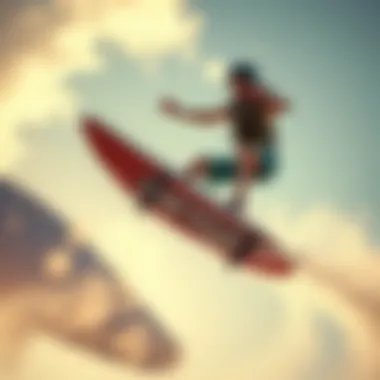
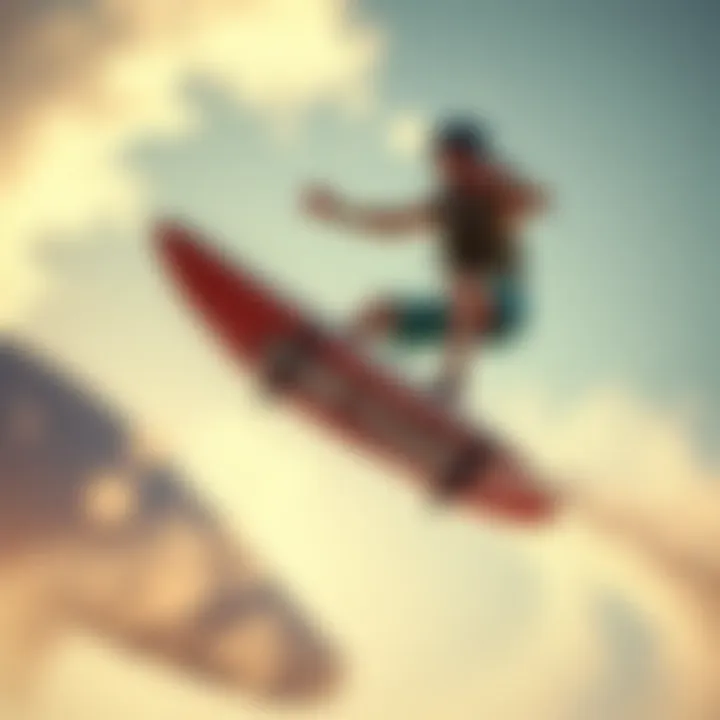
As the landscape of hover surfing continues transforming, digital applications emerge as outstanding tools for training and skill development. Training apps tailored specifically for hover surfing provide users with tutorials on techniques, safety checks, and performance tracking.
Imagine having access to a virtual coach right in your pocket. Many apps offer video analysis features, allowing surfers to upload their sessions and receive instant feedback. This technology significantly shortens the learning curve and guides users on ways to refine their methods. Moreover, social features within these apps allow surfers to connect, share experiences, and learn from one another.
In addition, apps can facilitate planning for ideal surfing conditions by providing real-time weather data, including wind patterns and tide schedules. Riders can make informed decisions about where and when to surf, which is essential for a thrilling yet safe experience.
In summary, the confluence of innovative gear designs and advanced digital training tools caters to a new generation of hover surfers, allowing them to hone their craft in ways that were unimaginable in the past. Embracing these technological advancements not only enhances performance but also enriches the overall experience of hover surfing.
Top Destinations for Hover Surfing
When it comes to hover surfing, picking the right spot can make or break your experience. This sport thrives on elements such as wind conditions, wave types, and accessibility to facilities. As kiteboarders know, some locations are simply better suited for mastering both the air and water. In this section, we will explore a couple of different categories of destinations: the widely recognized global hotspots, and some hidden gems that may not be on everyone's radar yet.
Global Hotspots
Global hotspots for hover surfing are usually bustling with enthusiasts and professionals alike. They offer ideal conditions consistently, ensuring that both beginners and seasoned riders can enjoy their time on the water. Here are some top contenders:
- Cape Town, South Africa: Known for its strong winds and stunning views of Table Mountain. The mix of flat water and waves caters to all skill levels.
- Hood River, Oregon, USA: This location is famed for its reliable winds and variety of water conditions. It provides an engaging experience for everyone from newbies to seasoned pros.
- Tarifa, Spain: Recognized as the wind capital of Europe, Tarifa attracts thousands of adventurers each year, offering a vibrant community and lively atmosphere.
These hotspots often have kite surfing schools, rental shops, and local events, allowing for a complete hover surfing experience.
"Finding the ideal location can make your surfing adventures memorable and rewarding slowly over time."
Hidden Gems for Enthusiasts
While global hotspots might attract crowds, there are some lesser-known hidden gems that offer excellent conditions with fewer people. These spots encourage more personalized adventures, allowing you to enjoy the tranquility of the water and sky. Some notable mentions include:
- Nags Head, North Carolina, USA: This area is often overlooked, yet it boasts consistent winds and flat waters, making it perfect for honing skills.
- Langebaan, South Africa: About an hour from Cape Town, Langebaan boasts beautiful lagoons where kiteboarders can fly freely and enjoy breathtaking scenery.
- Dahab, Egypt: Less commercialized than other locations, Dahab offers various wind conditions and warm waters, providing a dreamy backdrop for hover surfing.
These hidden locations also often provide an opportunity to connect with local communities. It’s a chance to experience the culture and lifestyle of the area while focusing on your passion for hover surfing.
Community and Events in Hover Surfing
When it comes to hover surfing, one cannot overlook the vibrant community that surrounds this thrilling sport. It’s not just about mastering the art of gliding over water and air; it’s also about forging connections with fellow enthusiasts and engaging in events that celebrate the joy of hover surfing. Communities and events serve to foster a sense of belonging, provide vital resources, and elevate the overall experience for participants.
Joining Hover Surfing Groups
Becoming part of a hover surfing group can be one of the most rewarding decisions for both new and experienced riders. These groups often range from local meetups to international organizations, providing a platform where members can share tips, experiences, and equipment recommendations.
- Learning Opportunities: By joining a group, individuals have access to a wealth of knowledge. Members frequently offer tutorials on technique, safety measures, and maintenance practices for gear.
- Social Events: Many hover surfing communities organize social events where surfers can gather, share stories, and even enjoy a little competition. These events can range from informal beach hangouts to structured gatherings with food, music, and activities.
- Resource Sharing: Groups often facilitate the sharing or renting of gear, which can be especially beneficial for newcomers who may not want to invest heavily in equipment right away.
- Networking: Through participation in groups, surfers can connect with others in the sport, which can lead to partnerships, sponsorships, or even job opportunities in the outdoor and adventure sports industry.
By leveraging the collective knowledge and resources found in hover surfing groups, participants can improve their skills and create lasting friendships. The power of community often transforms a solo sport into a collaborative adventure.
Competitions and Championships
Hover surfing competitions and championships play a pivotal role in pushing the boundaries of skill and innovation within the sport. These events not only serve as a great platform for showcasing talent but also encourage surfers to elevate their game.
- Competitive Spirit: The adrenaline rush that comes from competing can be a motivating factor for many surfers. Eager to test their mettle against others, participants can refine their skills under pressure, leading to overall improvement.
- Exposure to Techniques: Championships often draw in top-tier hover surfers who bring unique styles and techniques to the fore. For spectators and participants alike, there's much to learn from watching the best do their thing.
- Community Engagement: Events often bring together a diverse crowd, including families, friends, and sponsors. This creates an engaging atmosphere and fosters a deeper connection amongst participants and fans.
- Prizes and Recognition: Winning or even placing at a competition can elevate a surfer’s profile. Awards and sponsorships can lead to further opportunities within the sport, enhancing one’s career as a hover surfer.
"Competitions not only challenge you to improve but also unite the community, creating a shared excitement for the sport's growth."
The landscape of hover surfing is continually evolving, thanks in part to the events and competitions that encourage surfers to push their limits. Whether you’re an aspiring athlete or a seasoned pro, diving into this community can enrich your experience and foster growth.
In summary, the vibrancy of the hover surfing community, along with its highly anticipated events, serves as both a support network and a catalyst for improvement in the sport. Engaging with fellow enthusiasts and participating in competitions can elevate the experience, ensuring every ride is memorable.
Culmination: The Future of Hover Surfing
As the sport of hover surfing continues to rise in popularity, it is clear that its future holds immense potential. This closing section will unpack several important aspects that will shape the journey of hover surfing in the coming years. It emphasizes the need for innovation and sustainability, making these crucial elements for any enthusiast to consider.
Emerging Trends and Innovations
In recent years, hover surfing has seen remarkable advancements in technology and equipment. The integration of materials that provide better buoyancy and stability is just the tip of the iceberg. Innovations in kite design, such as foil kites that glide effortlessly over water, are pushing boundaries and enhancing the experience. Moreover, the blending of electric propulsion systems into hover surfboards is changing the game, allowing for more versatility and extended sessions, making it easier for riders to stay afloat longer and to ride in less windy conditions.
Here’s a snapshot of some notable trends:
- Smart Kites: Kites equipped with sensors providing real-time data on wind speed and direction.
- Lightweight Materials: Innovations like carbon fiber that reduce weight while maintaining strength.
- Customization: Riders are increasingly personalizing their setups to match their style and conditions, reflecting the ongoing trend towards unique, tailored experiences.
"Technology in hover surfing is not just about performance; it's about redefining what we can do on the water and in the air."
Encouraging Sustainable Practices
As the sport grows, so does its impact on the environment. Thus, it is essential for the hover surfing community to adopt sustainable practices. Selecting eco-friendly materials for gear, such as bio-resins for boards or recycled materials for kites, can significantly reduce the ecological footprint of this thrilling activity. Additionally, promoting responsible usage of natural sites, ensuring that surf spots are protected against overuse, wildlife disturbances, and pollution is imperative.
Some proactive steps, which can be taken by individuals and local communities, include:
- Organized Clean-Ups: Regularly scheduled clean-ups at popular hover surfing spots can help maintain pristine conditions.
- Awareness Campaigns: Informing fellow surfers about the importance of preserving marine and coastal ecosystems.
- Sustainable Events: Collaborating with organizations to host competitions that prioritize environmental responsibility.
By embracing sustainable practices, the hover surfing community can ensure that the thrilling experience of navigating waves and air will remain accessible for future generations.
At the end of the day, the future of hover surfing lies not just in progression and innovation, but in the thoughtful stewardship of both the sport and the environment it inhabits.



